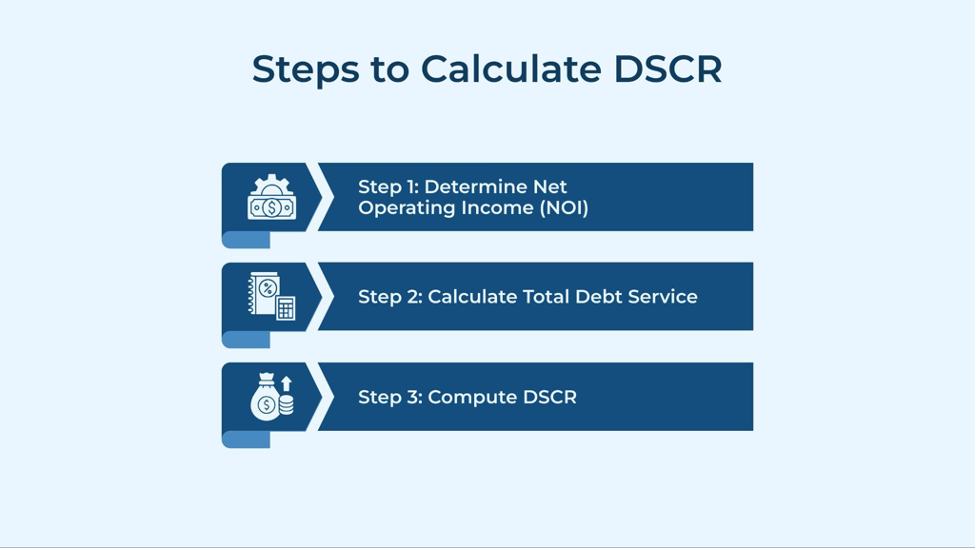
Financing a commercial property isn’t just about having a great investment opportunity—it’s about proving to lenders that your property can generate enough income to cover its debt. This is where the Debt Service Coverage Ratio (DSCR) comes into play. If your DSCR is too low, getting approved for a loan can be an uphill battle.
Most commercial lenders require a minimum DSCR of 1.25 or higher to provide a safety buffer against cash flow fluctuations. But what exactly is DSCR, and how do you calculate it to ensure your loan application stands out?
In this blog, we’ll break down what a DSCR loan is, why it matters, and how to calculate it step by step. Plus, we’ll share practical strategies to improve your DSCR and increase your chances of securing the best possible financing terms.
What is the Debt Service Coverage Ratio (DSCR)?
In real estate, DSCR measures a property’s cash flow relative to its debt obligations. It helps lenders determine whether a property generates enough income to cover its loan payments. A higher DSCR indicates better financial health and a lower risk of default, while a DSCR below 1 suggests that a property may struggle to meet its debt obligations.
Formula for DSCR
The formula for DSCR is:
Where:
Net Operating Income (NOI) = Gross Rental Income + Other Property Income – Operating Expenses
- Gross Rental Income: Total income from tenants.
- Other Property Income: Parking fees, service charges, etc.
- Operating Expenses: Property management fees, maintenance, utilities, property taxes, and insurance.
Total Debt Service (TDS) = Principal Repayment + Interest Payments + Other Fixed Debt Obligations
- Principal Repayment: The portion of the loan payment reducing the loan balance, if applicable.
- Interest Payments: The cost of borrowing capital.
- Other Fixed Debt Obligations: Includes lease payments (if applicable), balloon payments, and other contractual loan obligations.
Understanding DSCR Result
- DSCR of 1.25 or higher: Strong financial standing (rental income exceeds debt obligations by 25%)
- DSCR of 1.0: Break-even point (rental income just covers mortgage payments)
- DSCR below 1.0: Negative cash flow (rental income is insufficient to cover loan payments)
Why is DSCR Important?
Below are a few major reasons why DSCR is important:
Loan Approval
Lenders use DSCR as an essential metric to assess a borrower’s ability to repay a loan. A higher DSCR increases the chances of loan approval and allows borrowers to secure more favorable interest rates and terms. Many lenders require a minimum DSCR of 1.25 for commercial real estate loans, ensuring the property generates enough income to cover its debt obligations with a safety margin.
Financial Planning
Real estate investors rely on DSCR to determine whether they can afford additional debt without jeopardizing cash flow. A strong DSCR helps investors plan future acquisitions, expansions, or renovations while maintaining financial stability. By monitoring DSCR, investors can proactively manage operating expenses and optimize rental income to maintain a healthy financial position.
Investment Analysis
Investors use DSCR to evaluate the financial health of income-generating properties before making a purchase. A higher DSCR indicates that a property generates sufficient cash flow to cover mortgage payments, reducing the risk of default. For properties with a DSCR below 1.0, investors must assess whether future rent increases, property improvements, or restructuring loan terms (such as interest-only payments) can improve cash flow.
Steps to Calculate DSCR

Calculating the Debt Service Coverage Ratio (DSCR) is a straightforward process that involves three main steps. By breaking it down, you can accurately assess whether your income is sufficient to cover your debt obligations.
Step 1: Determine Net Operating Income (NOI)
Net Operating Income (NOI) represents the income generated from a property after deducting operating expenses before accounting for interest and taxes. It clearly shows the cash flow available to cover debt obligations.
For example, suppose a property generates $500,000 in total rental income and incurs $200,000 in operating expenses. In that case, the NOI is calculated by subtracting these expenses from the rental income, resulting in an NOI of $300,000.
This figure is critical because it shows how much income is available to service debt and maintain operations.
Step 2: Calculate Total Debt Service
Total Debt Service refers to the sum of all periodic payments required to service debt, including both principal and interest payments. This calculation is essential as it reflects the total outflow needed to meet the debt obligations within a given period.
For instance, if a company has an annual loan repayment obligation of $150,000—which is made up of $100,000 in principal and $50,000 in interest—then the Total Debt Service is $150,000. This step ensures you understand the full scope of the debt payments that the NOI must cover.
Step 3: Compute DSCR
The Debt Service Coverage Ratio (DSCR) is computed by dividing the Net Operating Income (NOI) by the Total Debt Service. Using the figures from our examples, dividing an NOI of $300,000 by a Total Debt Service of $150,000 results in a DSCR of 2.0.
This means the property generates twice the income required to cover its debt payments, indicating a strong financial position.
A DSCR above 1 suggests sufficient income to manage debt, whereas a DSCR below 1 indicates potential difficulties in meeting debt obligations.
How Do You Calculate DSCR with Multiple Loans?
DSCR must be calculated using total debt service across all obligations for investors or businesses with multiple loans. It is done as follows:
Example
Consider a property generating:
- Gross Rental Income: $500,000
- Other Income: $50,000
- Operating Expenses: $200,000
NOI=(500,000+50,000)−200,000=350,000
If the borrower has three loans with the following annual debt payments:
- Loan 1: $100,000
- Loan 2: $75,000
- Loan 3: $50,000
TDS=100,000+75,000+50,000=225,000
Now, computing DSCR:
DSCR=350,000/225,000=1.56
A DSCR of 1.56 means the property earns 56% more than its total debt obligations, making it financially stable in the lender’s view.
What Are the Common Mistakes When Calculating DSCR?
Accurately calculating DSCR is essential for making financial decisions. However, miscalculations can lead to incorrect assessments of a property’s financial health and impact loan approvals. Below are some of the most common mistakes:
1. Misclassifying Expenses
Some businesses mistakenly include non-operating expenses, such as depreciation, when calculating Net Operating Income (NOI). Since DSCR focuses on operational cash flow, only expenses related to the property’s daily operations should be deducted.
2. Ignoring Variable Interest Rates
DSCR calculations should account for the total debt service and potential fluctuations in interest rates. Failing to consider these factors may lead to an overly optimistic DSCR.
3. Overestimating Rental Income
Some investors assume full occupancy or projected rent increases when estimating NOI. However, vacancies, market fluctuations, and tenant defaults can impact cash flow. Using conservative and realistic income projections ensures a more accurate DSCR.
4. Using Annual vs. Monthly Figures Inconsistently
When calculating DSCR, using consistent time frames for both NOI and total debt service is crucial. Mixing monthly NOI with annual debt service (or vice versa) can lead to incorrect DSCR results. Always ensure both values are calculated on the same basis.
5. Not Adjusting for Seasonal Cash Flow Variations
For properties with seasonal revenue patterns (e.g., summer property rentals), DSCR should reflect average NOI over an extended period rather than a month or quarter. Failing to adjust for seasonal fluctuations can make DSCR appear stronger or weaker than it is.
Major Factors Influencing DSCR
A DSCR loan has several requirements. It is mainly affected by the following factors:
Income Generation
Income generation is fundamental to DSCR, particularly for real estate investments where rental income is pivotal. High occupancy rates, favorable lease terms, and strong market demand increase the Net Operating Income (NOI).
When rental properties consistently achieve high occupancy and secure competitive rents, higher NOI boosts the DSCR. Conversely, if occupancy rates drop or rent levels fall below market averages, the reduced income can lead to a lower DSCR.
Operating Expenses
Operating expenses directly impact the NOI and, consequently, the DSCR. Efficient management of costs—such as maintenance, utilities, property management fees, and insurance—becomes crucial. When expenses are controlled, the positive effect on cash flow helps maintain or improve the DSCR. However, unexpected increases or poorly managed costs can erode NOI, decreasing the DSCR and signaling potential financial stress.
Debt Structure and Terms
The structure and terms of the loan significantly influence the DSCR. This factor encompasses the total debt service, including principal and interest payments. Favorable loan conditions, such as lower interest rates, extended repayment periods, or interest-only options, can effectively reduce the debt service burden, thereby enhancing the DSCR.
Any changes in these terms or fluctuations in market interest rates can directly impact the debt obligations, altering the DSCR accordingly.
External Economic and Market Factors
External economic conditions and market trends also play a crucial role in determining the DSCR. Economic downturns, local or regional market demand shifts, and broader economic challenges can affect revenue and expense levels.
For instance, during an economic slowdown, rental incomes might decline while operating expenses remain fixed, resulting in a lower DSCR. Effective forecasting and proactive management are essential to mitigate these external risks and maintain a healthy DSCR over time.
Apart from DSCR, another major factor lenders consider in commercial real estate financing is the Loan-to-Value (LTV) ratio. While DSCR focuses on cash flow and repayment ability, LTV assesses the loan amount relative to the property’s value. Understanding both metrics is essential for securing favorable loan terms.
Debt Service Coverage Ratio vs. Loan-to-Value (LTV)
While DSCR evaluates a borrower’s ability to meet debt obligations through income, Loan-to-Value (LTV) focuses on the property’s appraised value relative to the loan amount. Lenders use both metrics together to assess risk and determine loan eligibility.
Differences Between DSCR and LTV
| Metric | What It Measures | Formula | Importance |
| DSCR | Cash flow coverage for debt | Net Operating Income ÷ Total Debt Service
|
Determines if a property generates enough income to cover debt obligations
|
| LTV | Loan amount compared to property value
|
(Loan Amount ÷ Property Value) × 100
|
Assesses risk exposure for lenders
|
Why Both Matter
A strong DSCR ensures a property generates enough income to cover debt payments, while a low LTV shows a borrower has significant equity in the property, reducing lender risk. Some lenders may approve higher LTV loans if DSCR is strong, and vice versa.
Accelerate Your Business Growth with Bluestone Commercial Loans
Whether you’re a small business owner or a real estate investor, Bluestone offers tailored financing solutions to meet your needs:
- Bridge Loans: Gain quick access to capital for time-sensitive transactions, ensuring you secure the deal before conventional banks can process your application.
- Fix-and-Flip Loans: Efficiently purchase, renovate, and resell properties with our specialized funding to keep your project moving forward.
Why Choose Bluestone?
- Speed & Flexibility: Recognizing that time is critical, we provide fast, adaptable financing options with competitive rates and minimal paperwork.
- Proven Track Record: Our extensive portfolio features a variety of high-quality, business-purpose loans secured by commercial real estate—from modest amounts to multi-million-dollar investments.
- Personalized Service: Enjoy direct access to our experienced team, which is dedicated to delivering financial solutions tailored to your unique goals. We take the time to understand your objectives and act quickly to help you succeed.
Take the next step toward achieving your business goals with Bluestone Commercial Loans. Apply now and secure the funding you need.
